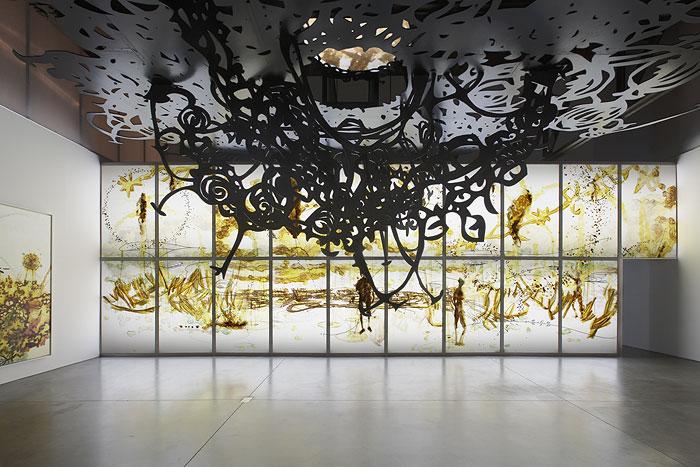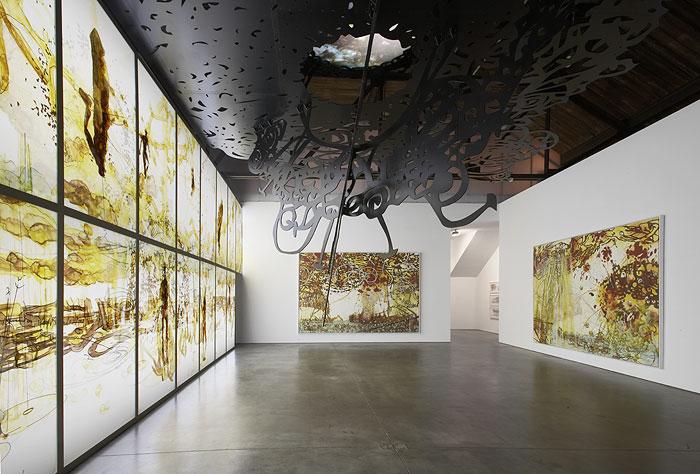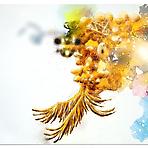Matthew Ritchie
"The Universal Adversary"
September 21 – October 28, 2006
Main Gallery
Matthew Ritchie
"The Universal Adversary"
September 21 - October 28, 2006
"Their appearance and their work was as if a wheel within a wheel; as for their rings, they were so high they were dreadful and their rings were full of eyes, round about them four. And when the living creatures went, the wheels went with them for the spirit of the living creature was in the wheels." Ezekiel I: XVI-XX
This fall Andrea Rosen Gallery is excited to present "The Universal Adversary", the first New York solo exhibition of work by Matthew Ritchie in four years and the first exhibition in the gallery's redesigned space. A major architectural intervention, a folded black latticework sky almost 30 feet across, floats at the literal and conceptual center of the exhibition. The folded sky fills the main gallery, bifurcating the space into a floating viewing platform and a dense netherworld filled with new paintings. The two levels are connected by a rapturous two-story, 40-foot long wall of illuminated images, depicting evanescent figures rising into a sulfurous sky. Adventurous viewers can ascend to the second level and walk out to an oculus at the core of a suspended sphere where a projection of a parallel world, a vision of a possible future, unfolds its story.
Not one of us truly knew whose invisible hands shaped and steered them, who keeled and captained their ship. With what glass and devil. What I'm saying is; not one of us, even those who believed they were true, could read that kind of weather. Coffin weather.
While "The Universal Adversary" is the first exhibition of this magnitude in the gallery, Ritchie has been working on an architectural scale for the last five years, beginning with Games of Chance And Skill in 2002, a permanent installation created for MIT, and to be followed this summer by Stare Decisis, a GSA-commissioned installation for a new Federal Courthouse in Oregon, designed in conversation with Pritzker prize-winning architect Thom Mayne. Recently Ritchie has been collaborating with NY based architect Philip Wu on a permanent commission for CACI, Brazil, as well as London-based architect David Adjaye on a temporary pavilion that will contain an interactive performance space designed by the artist. Uniting all these projects is an interest in the question of how to create a space that is simultaneously a form of information.
Competing versions of reality are still being debated. The holographic principle proposes that volume itself is somehow illusory: that mass occupies area, not volume, and so the universe is really a hologram, isomorphic to the information "inscribed" on its boundaries. In other words, our universe is a picture and we are constantly creating it, minute by minute.
For his September exhibition in New York, Ritchie's works evoke an atmosphere of indeterminate crisis, precipitated around an entity called The Universal Adversary, a shadowy character who seems to have been conjured from our collective past to imperil our immediate future.
In 2005, the United States Government classified fifteen scenarios as major threats to the US population. Collectively these are known as the Universal Adversary. Nowhere in this list are the known causes of major threats to human life of income disparity, endemic disease, resource depletion, or radical climate change.
"We're an empire now, and when we act, we create our own reality. And while you're studying that reality - we'll act again, creating other new realities, which you can study too." G.W. Bush Administration
Acclaimed for his ambitious and influential installations of painting, drawing, lightboxes, sculpture, and projections, Ritchie's wide-ranging study of both the factual and the fictional is a defining characteristic of his work. He is especially unusual in the depth of his involvement with multiple fields of investigation. As is typical for the artist, for his exhibition We Want To See Some Light at Portikus, Frankfurt, in 2005, he collaborated with a visual neurologist, an architect, a group of students and a philosopher to examine the physical limits of generated knowledge. The British-born artist has delivered a series of lectures in forums as diverse as the prestigious 2005 Einstein Centennial Conference in Berlin, The Believer magazine's recent "literary variety show" for American PEN moderated by John Hodgman, and the Whitney Museum's conference on the work of Robert Smithson. In 2001, Time magazine included Ritchie in its list of 100 innovators of the new millennium, naming him as a person exploring "the unthinkable or the not-yet-thought."
Despite our best efforts, we cannot identify 95% of the material in the universe. In particular a missing substance dubbed 'Cold Dark Matter' is required to explain the existence of the physical structure of reality. Determining the nature of this missing mass is one of the most fundamental problems in modern cosmology.
More omnivorous than omnipotent, encompassing everything from cutting-edge physics, ancient myth, economic theory, neo-noir short stories and medieval alchemy to contemporary politics, Ritchie's installations are based equally on an internally consistent fictional ecology and the constantly changing factual understanding of our universe. The Universal Adversary and the Holographic Principle; like Ezekiel's apocalyptic visions and Dark Matter, are all metaphors for the idea of the unknowable; which is always stranger and more challenging than we can imagine. This exhibition, with pictures folded into places and stories wrapped inside projections, asks us to engage with the extraordinary truth that we are all generating our own temporary realities, our own universal adversaries.
Matthew Ritchie was born in 1964; he lives and works in New York City. Since his last exhibition in New York, he has been included in group exhibitions worldwide including: "Remote Viewing" at the Whitney Museum of American Art in 2005, the Sao Paulo Bienal XXVI & the inaugural exhibition of the 21st Century Museum of Modern Art in Kanazawa in 2004, and the 2002 Sydney Biennial. His recent solo exhibition "Proposition Player," organized by the Contemporary Arts Museum, Houston, traveled to MASS MoCA and The Fabric Workshop and Museum in 2005. Major Installation works by Ritchie will be on view through 2006 in both "Radar," the inaugural exhibition of the Denver Art Museum and "The Guggenheim" at the Kunstmuseum Bonn. The gallery opening will coincide with the publication of Matthew Ritchie: Incomplete Projects 01-07, an artist's book produced in collaboration with Purtill Family Business. A three-dimensional artist's book is in development with Rizzoli and is planned for release in 2007.




















